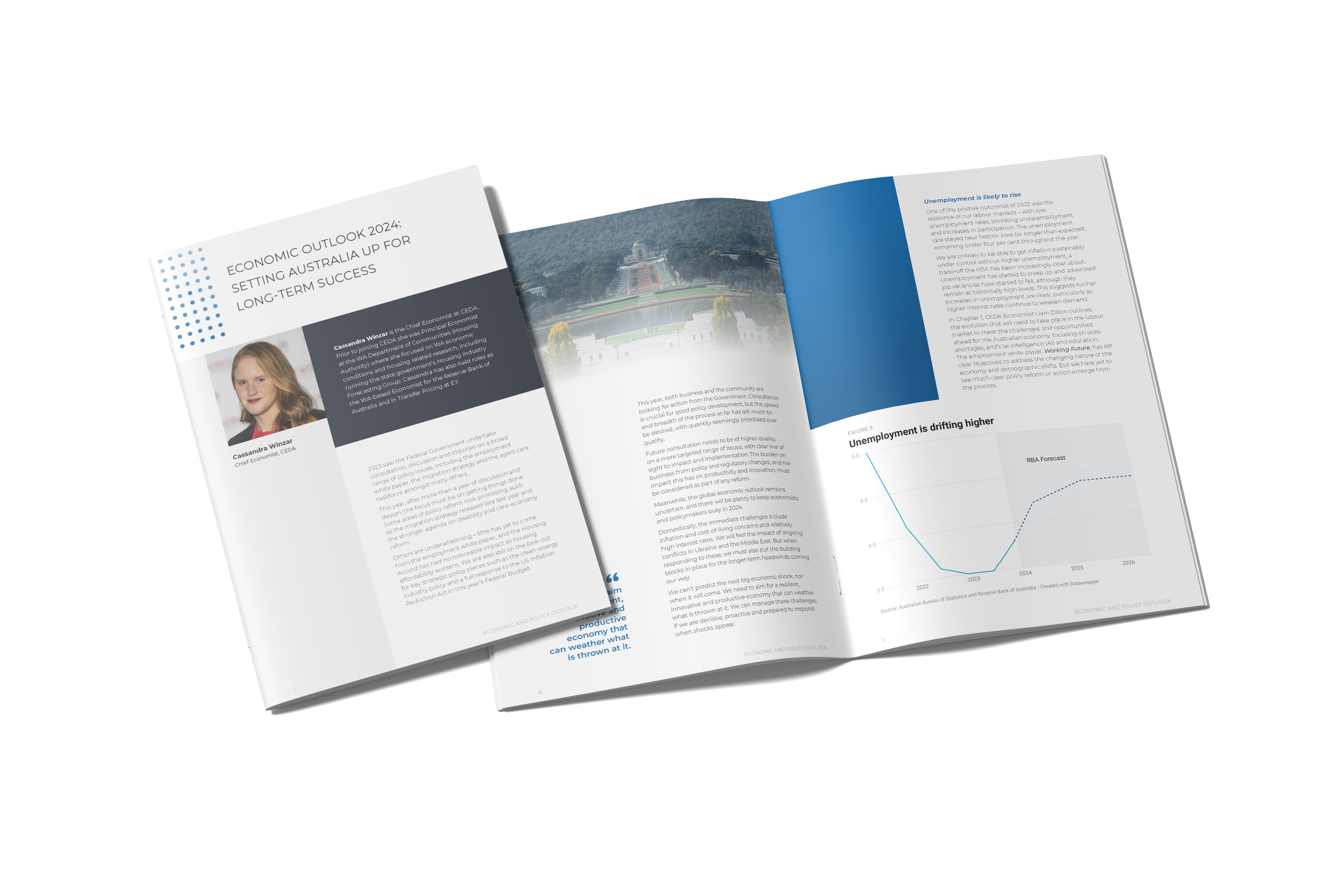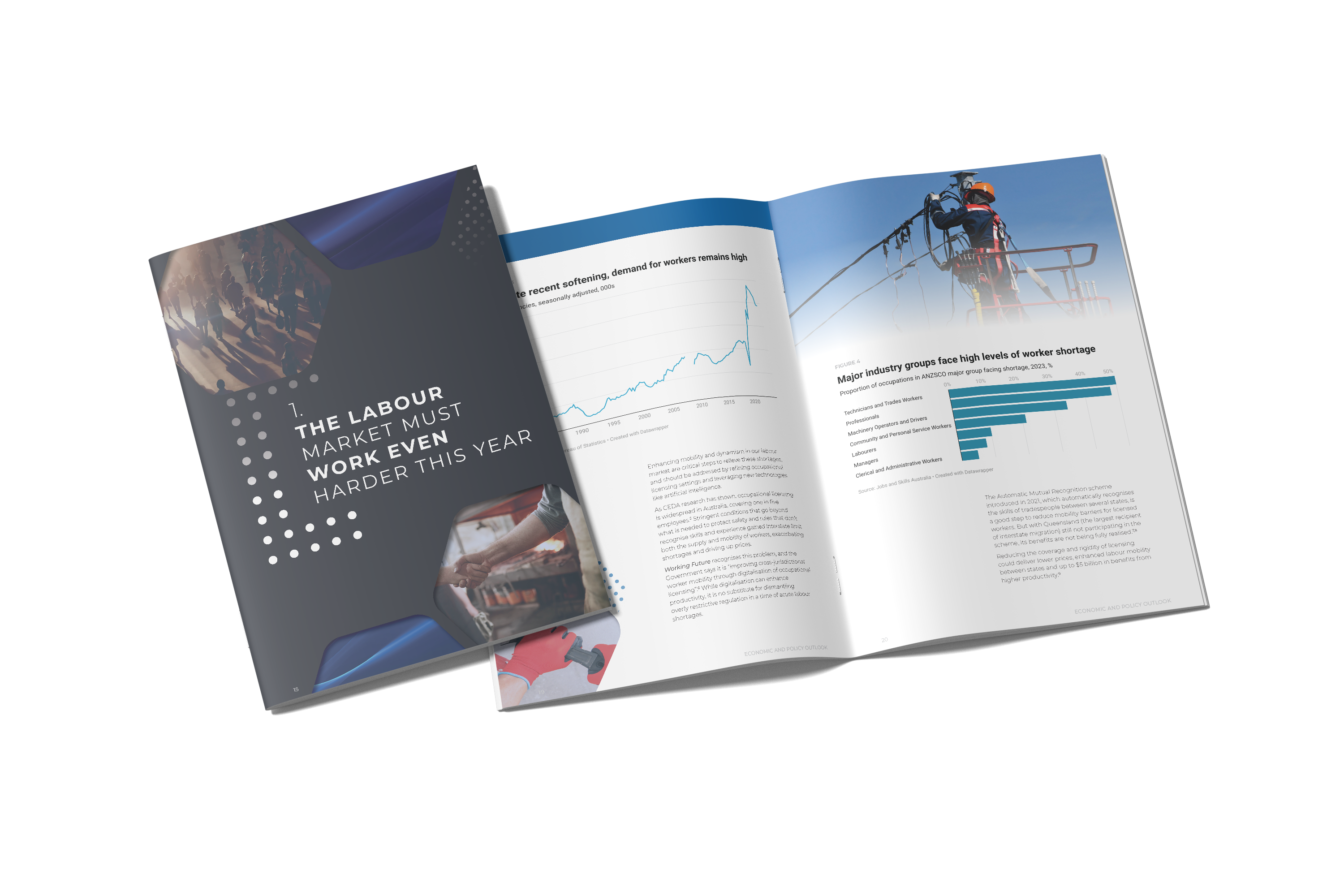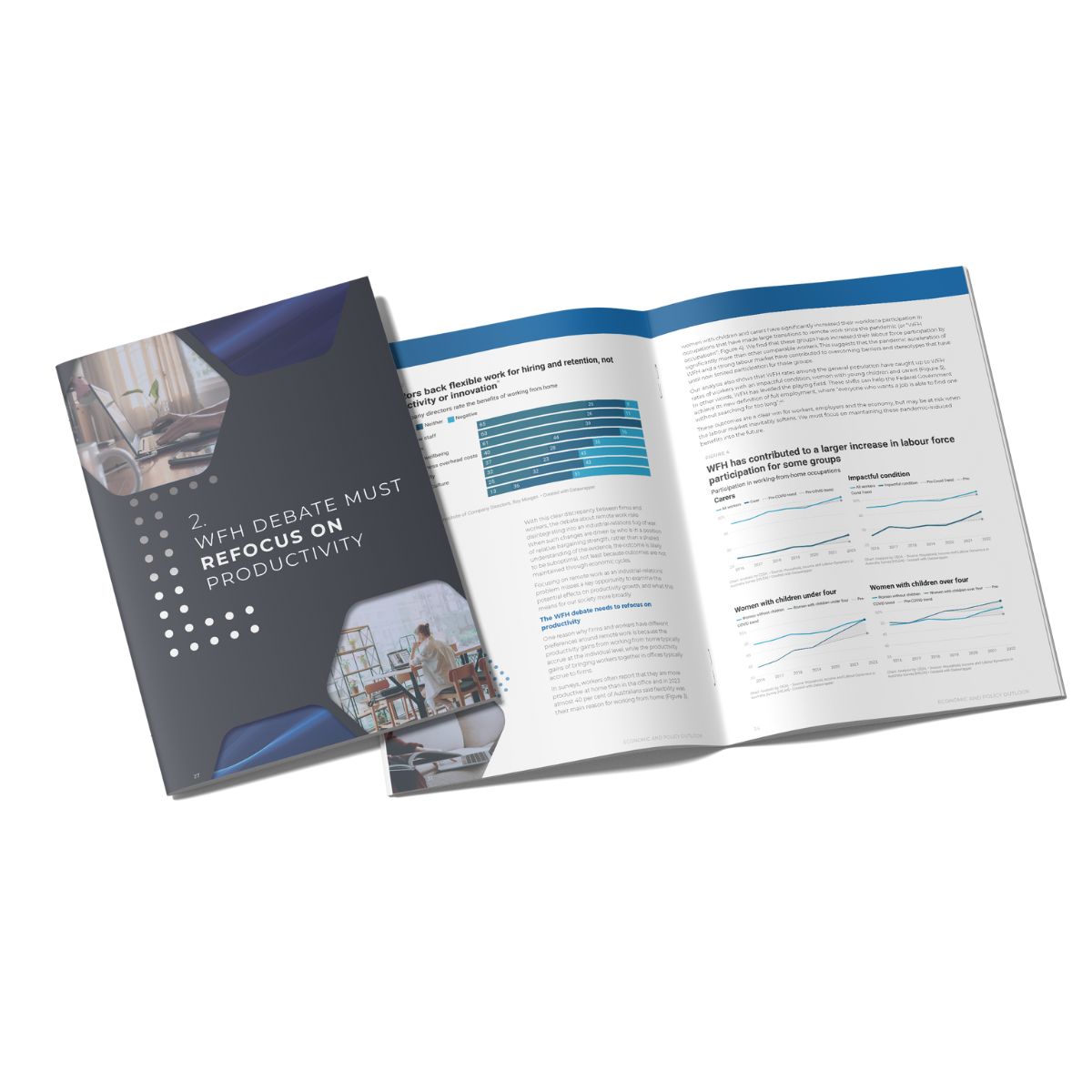Explore our Climate and Energy Hub
2023 saw the Federal Government undertake consultation, discussion and inquiries on a broad range of policy issues, including the employment white paper, the migration strategy and the aged-care taskforce amongst many others.
This year, after more than a year of discussion and design, the focus must be on getting things done. Some areas of policy reform look promising, such as the migration strategy released late last year and the stronger agenda on disability and care-economy reform.
Others are underwhelming – little has yet to come from the employment white paper, and the Housing Accord has had no noticeable impact as housing affordability worsens. We are also still on the look-out for key strategic policy pieces such as the clean-energy industry policy and a full response to the US Inflation Reduction Act in this year’s Federal Budget.
This year, both business and the community are looking for action from the Government. Consultation is crucial for good policy development, but the speed and breadth of the process so far has left much to be desired, with quantity seemingly prioritised over quality.
Economic outlook

Cassandra Winzar
Chief Economist, CEDA
Future consultation needs to be of higher quality, on a more targeted range of issues, with clear line of sight to impact and implementation. The burden on business from policy and regulatory changes, and the impact this has on productivity and innovation, must be considered as part of any reform.
Meanwhile, the global economic outlook remains uncertain, and there will be plenty to keep economists and policymakers busy in 2024.
Domestically, the immediate challenges include inflation and cost-of-living concerns and relatively high interest rates. We will feel the impact of ongoing conflicts in Ukraine and the Middle East. But when responding to these, we must also put the building blocks in place for the longer-term headwinds coming our way.
We can’t predict the next big economic shock, nor when it will come. We need to aim for a resilient, innovative and productive economy that can weather what is thrown at it. We can manage these challenges if we are decisive, proactive and prepared to respond when shocks appear.
Short-term challenges
Slow growth ahead
Despite concerns about the risk of a hard landing, the Australian economy made it through 2023 in fairly good shape, helped by a resilient labour market, buoyant business conditions and strong commodity prices. Risks of a recession this year are low, but that doesn’t mean things will be easy.
Inflation and cost-of-living continue to bite
Inflation is moving in the right direction but is still too high. It is likely to remain the focus of economic policy and public debate throughout 2024. Globally, inflation is clearly receding. This will assist the Australian outlook. However, domestic inflation is increasingly homegrown and driven by demand for services, rather than imported through goods. This may prove more difficult to contain, and will make it harder to reset the inflation expectations of both consumers and businesses.
.png)
Economic outlook 2024: Setting Australia up for long-term success
Read the Economic Outlook chapter
Unemployment is likely to rise
One of the positive outcomes of 2023 was the resilience of our labour markets – with low unemployment rates, shrinking underemployment and increases in participation. The unemployment rate stayed near historic lows for longer than expected, remaining under four per cent throughout the year.
The Federal Government and RBA must be on the same page
2023 proved a challenging year for coordination on economic policy, with monetary and fiscal policy at times appearing to be heading in opposite directions, particularly on inflation and cost-of-living relief. The Federal Government has also renewed its commitment to full employment at the same time as the RBA has suggested that an increase in unemployment is needed to bring inflation sustainably under control. These tradeoffs need to be openly discussed and there should be a clear narrative and direction around goals and timing.
Housing shortages will continue and pressure governments to act
Governments must take tangible steps to fix the acute housing shortages throughout much of Australia in 2024. The problems in the housing market have been building for some time, and cannot be resolved overnight, but the pace of reform must be ramped up. We risk significant intergenerational inequality and further entrenching disadvantage in some parts of the community if we cannot provide affordable and adequate housing across the country.
.gif)
CEDA's Economic and Policy Outlook for 2024
Read the full report now
Among the many surprises that accompanied the COVID-19 pandemic, few predicted the surge in employment that has supported the resilience of the economy ever since.
The steep fall in the unemployment rate has been widely celebrated – it held steadily below four per cent throughout 2023. But this has coincided with a new headache – acute labour shortages.
Rather than focusing on the challenges of high unemployment, the Federal Government‘s Jobs and Skills Summit and subsequent employment white paper, Working Future, instead tackled how to address a tight labour market and skills shortages.
Released late last year, the paper maps the Government’s ambition for the labour market and focuses on the structural shifts underway in our economy, from an ageing population and accelerated digitalisation to the global energy transition. Central to this is a vision of full employment that creates “an economy where everyone who wants a job is able to find one without having to search for too long”.
Workforce
.png)
Liam Dillon
Economist, CEDA
There is a tension between this goal of full employment and the Reserve Bank’s consistent messaging that higher unemployment is the cost we bear to get inflation under control.
The Government must ensure its employment measures don’t work against monetary policy and risk stoking inflation, while making the trade-offs clear.
The objectives in Working Future represent the ultimate goal of any labour market – achieving high productivity and wage growth coupled with low unemployment and sustainable inflation. This is easier said than done. To move towards this goal, the Government must act on three key challenges.
First, we must improve labour mobility and dynamism by tackling regulatory barriers and focusing on productivity. Second, improved participation and inclusivity among groups who have struggled to engage fully in the workforce must continue to be a priority. Finally, we must address known and persistent skill shortages for structurally significant areas like healthcare, technology and climate change. This means bolstering the supply of workers through a responsive education system and optimising our migration system.

1. The labour market must work even harder this year
Read the Workforce chapter now
Increased labour mobility and dynamism can put the right skills in the right places
Many of the occupations in shortage have had an inadequate supply of workers for more than two years.
Enhancing mobility and dynamism in our labour market are critical steps to relieve these shortages, and should be addressed by refining occupational licensing settings and leveraging new technologies like artificial intelligence.
As CEDA research has shown, occupational licensing is widespread in Australia, covering one in five employees. Stringent conditions that go beyond what is needed to protect safety and rules that don’t recognise skills and experience gained interstate limit both the supply and mobility of workers, exacerbating shortages and driving up prices.
.gif)
CEDA's Economic and Policy Outlook for 2024
Read the full report now
Of the many impacts of the COVID-19 pandemic, none have shaken the world of work as much as the shift to remote working and working from home (WFH).
Remote working in some form looks like it is here to stay. Yet there is currently a tension between employees wanting to work flexibly and employers increasingly pushing for a return to the office.
Balancing these different perspectives will be a key challenge over the year ahead. Managers now find themselves grappling with the nuance and complexity of new ways of working, as well as competing priorities and interests, as the remote-work experiment continues to play out in real time.
To allow this debate to disintegrate into a tug of war between firms and workers would be a missed opportunity. Instead, we should refocus on the productivity and participation gains that new ways of working could unlock, to get the right balance between diversity and inclusion, collaboration and innovation, and mental health and employee engagement.
Unlocking the productivity potential of WFH will require willingness from managers to experiment and commit to changes that make WFH more effective but also add value in the office. Further research and analysis will also be needed to learn more about the longer-term implications of new ways of working.
With labour productivity growth at its slowest pace in decades, now is the time to pull every lever at our disposal. Remote work needs to be part of the productivity discussion.
Working from home

Melissa Wilson
Senior Economist, CEDA
.png)
James Brooks
Economist, CEDA
The current state of remote work
Work done outside an employer’s office (remote work or working from home) is clearly popular among workers. The latest ABS data show 37 per cent of Australian workers, including 60 per cent of managers and professionals, were working from home on a regular basis in August 2023, up from around five per cent pre-pandemic. This is broadly in line with the Productivity Commission’s estimate that 35 per cent of jobs can be done from home, and represents a dramatic shift that has important implications for Australia’s overall productivity growth.
.png)
2. WFH debate must refocus on productivity
Read the WFH chapter now
Diversity and inclusion
Firms benefit from hiring from a larger, more diverse group of workers as they are more likely to find a worker with the skills and talents to match the firm’s needs. Diversity within teams also enriches the quality of inquiry, problem solving and decision-making.
CEDA analysis of the Household Income and Labour Dynamics in Australia (HILDA) data Release 22, which includes responses from the second half of 2022, has found that workers with a health condition or disability that affects their ability to work (an impactful condition), women with children and carers have significantly increased their workforce participation in occupations that have made large transitions to remote work since the pandemic (or “WFH occupations”).
We find that these groups have increased their labour force participation by significantly more than other comparable workers. This suggests that the pandemic acceleration of WFH and a strong labour market have contributed to overcoming barriers and stereotypes that have until now limited participation for these groups.
WFH has contributed to a larger increase in labour force participation for some groups
.gif)
CEDA's Economic and Policy Outlook for 2024
Read the full report now
Tough decisions will be needed on energy policy this year to ensure Australia meets its emissions-reduction targets, while protecting energy affordability and reliability of supply.
There are looming challenges on all three fronts, as policy uncertainty over the last 15 years has held back investment in the necessary generation, storage and network assets.
Reliability challenges are intensifying
Every mainland state will face reliability issues over the next decade based on current investment plans, with some states facing reliability issues from this year.
The Australian Energy Market Operator (AEMO) has warned that the reliability of the National Electricity Market is at risk unless there is urgent investment, with 62 per cent of coal-fired power plants expected to close before 2033.
Considering only committed energy-infrastructure investment, AEMO says reliability risks will exceed the relevant standard from 2023-24 in Victoria and South Australia, 2025-26 in NSW and 2029-30 in Queensland.
Energy
.png)
Andrew Barker
Senior Economist, CEDA
Emissions target in doubt
The Federal Government has legislated to achieve net-zero greenhouse-gas emissions by 2050, with an interim goal to cut emissions by 43 per cent from 2005 levels by 2030. Based on policies implemented or where design is well progressed, Australia is projected to cut its emissions by 37 per cent by 2030, missing its target by 35 million tonnes of carbon dioxide.
The Government’s plans place much of the burden on the electricity sector. While this reflects the ready availability of renewable-generation projects, there are big challenges to recruit the skills, expand the networks and get the planning approvals necessary to roll these out at sufficient scale.

3. A critical year for emissions targets and energy policy
Read the Energy chapter now
The Government’s plans place much of the burden on the electricity sector. While this reflects the ready availability of renewable-generation projects, there are big challenges to recruit the skills, expand the networks and get the planning approvals necessary to roll these out at sufficient scale.
Investment in renewable energy has boomed over the past decade, but large-scale investment has been in gradual decline since the Renewable Energy Target was met in 2020, reducing the incentive for new generation. Prior to the expansion of the Capacity Investment Scheme in late 2023, state-based measures were only on track to deliver around 70 per cent renewables by 2030. Investment slowed further over the past year due to higher project costs, complex permitting processes, a congested grid and intensifying global competition in the race to net zero.
.gif)


.png)


